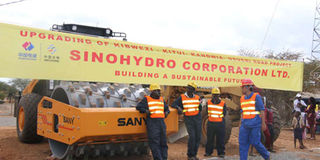Critical road projects are nearing completion

Engineers and machines for the construction of the Kibwezi-Kitui-Kandwia-Usueni road in June 2016. PHOTO | THOMAS WAITA | NATION MEDIA GROUP
What you need to know:
The plan to tarmac the Kibwezi-Kitui road in the eastern region dates back to 2011, when the government entered into a commercial agreement with Sinohydro Corporation of China for the construction of the 145km stretch for Sh18.4 billion.
This was a pre-condition for the financial support from the Export-Import Bank of China.
About five years later, the scope of the work was changed, increasing the length to 192km at the same cost.
A number of critical road projects that were previously no more than just a catalogue of good intentions on paper are being implemented, with some nearing completion. This is being done countrywide and the citizens are beginning to reap the economic and social benefits.
The plan to tarmac the Kibwezi-Kitui road in the eastern region dates back to 2011, when the government entered into a commercial agreement with Sinohydro Corporation of China for the construction of the 145km stretch for Sh18.4 billion. This was a pre-condition for the financial support from the Export-Import Bank of China.
SCOPE CHANGED
About five years later, the scope of the work was changed, increasing the length to 192km at the same cost. The latest scope includes the following sections and details: Kibwezi-Kitui (145km); Kabati-Migwani (16.7km); Kibwezi township (3km); Ikutha township (3km); Mutomo township (4km); Kitui township (3km); interchanges in Kibwezi and Kitui; and rehabilitation of the Kitui-Kabati road and social amenities on the Kibwezi-Kitui road. The 420km project shall be implemented by Sinohydro Corporation under an engineer procure construct contract. It is being jointly financed by our government and the Export-Import Bank of China. The project has been divided into three key lots to be implemented concurrently and completed in December 2019: Kibwezi-Mutomo-Kitui (145km); Kitui-Mwingi-Kandwia (103km) and lastly Kandwia-Tseikuru-Usueni-Mikinduri-Muriri (172km). The work consists of upgrading the existing road to an international trunk road standard with a seven-meter wide carriageway and two-metre wide shoulders on both sides and four new bridges. Others are seven interchanges or intersections in Kibwezi, Kitui, Syongila, Kabati, Mwingi, Mikinduri and Muriri, new bridges, one being 285 metres long across Tana River in Usueni, several other drainage structures, three roadside stations in Kibwezi, Kitui and six bypasses in Kibwezi, Ikutha, Mutomo, Ikanga, Kitui and Mwingi towns.
FAMOUS ROAD
President Uhuru Kenyatta launched the project on December 6 and work is continuing on the 145-km Kibwezi-Kitui segment, easily one of the most famous roads in Ukambani, which despite promises by previous leaders to fund its upgrade to bitumen standards, is finally been done. The project has started with the construction on two fronts, namely kilometre 21 to 27 and kilometre 68 to 73. Kilometre zero is in Kibwezi. The design for 40 kilometres has been completed in detail and supervision by a consultant appointed by the Kenya National Highways Authority is on schedule. The project has not been without challenges. Key among these is the imposition of fees and levies on the contractor, principally by the county government of Kitui. There is also a need to relocate electricity poles not aligned with the road. These should be resolved with both the county and Kenya Power.
ALTERNATIVE ROUTE
Part of the larger Mombasa–Addis Ababa corridor, which links the Mombasa-Nairobi highway in Kibwezi and the Nairobi-Addis Ababa highway in Isiolo, this project provides an alternative, shorter route to Moyale and ultimately Addis Ababa.
With this option, traffic from Mombasa need not go through Nairobi. But the transformative potential of the Kibwezi-Kitui-Mwingi-Usueni-Mikinduri-Muriri road lies in its huge economic promise. This road will open up huge swathes and unlock the potential of six counties: Makueni, Kitui, Tharaka-Nithi, Meru, Isiolo and Marsabit. Embu has its own Chiakariga-Ena road. The project will help to ease trade between the Mount Kenya, Lower Eastern and Coastal regions. Kibwezi and Usueni will benefit from improved movement of goods and people. Transportation of produce from Kitui and Tharaka Nithi counties to the nearby towns will be much easier, enhancing food security. Another sector expected to receive a boost is tourism through improved links to Tsavo East National Park, Kitui South Game Reserve Mwingi National Reserve, Meru National Park and Kora Game Reserve.
MINERAL-RICH HINTERLAND
The road traverses a mineral-rich hinterland, with commercially viable coal deposits in the Mui basin; limestone in Mutomo; and iron ore in Ikutha. It will also bring auxiliary infrastructure such as power, water, telecommunication and social amenities. This project will be a major boost in the development of the Mombasa-Isiolo-Moyale corridor and the Lamu Port–South Sudan–Ethiopia Transport Corridor project.
John Mosonik is the principal secretary for Infrastructure.





